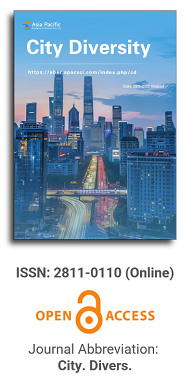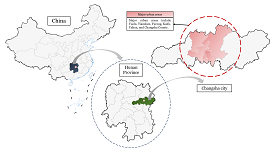
Asia Pacific Academy of Science Pte. Ltd. (APACSCI) specializes in international journal publishing. APACSCI adopts the open access publishing model and provides an important communication bridge for academic groups whose interest fields include engineering, technology, medicine, computer, mathematics, agriculture and forestry, and environment.

As China's pillar industry, the property market has suffered a considerable impact in recent years, with a decline in turnover and many developers at risk of bankruptcy. As one of the most concerned factors for stakeholders, housing prices need to be predicted more objectively and accurately to minimize decision-making errors by developers and consumers. Many prediction models in recent years have been unfriendly to consumers due to technical difficulties, high data demand, and varying factors affecting house prices in different regions. A uniform model across the country cannot capture local differences accurately, so this study compares and analyses the fitting effects of multiple machine learning models using February 2024 new building data in Changsha as an example, aiming to provide consumers with a simple and practical reference for prediction methods. The modeling exploration applies several regression techniques based on machine learning algorithms, such as Stepwise regression, Robust regression, Lasso regression, Ridge regression, Ordinary Least Squares (OLS) regression, Extreme Gradient Boosted regression (XGBoost), and Random Forest (RF) regression. These algorithms are used to construct forecasting models, and the best-performing model is selected by conducting a comparative analysis of the forecasting errors obtained between these models. The research found that machine learning is a practical approach to property price prediction, with least squares regression and Lasso regression providing relatively more convincing results.
Dialect diversity and market integration: From the perspective of city circle
Vol 5, Issue 1, 2024
Download PDF
Abstract
China, as a transitional economy, faces a high level of market segmentation among administrative regions, which lowers the efficiency of resource allocation and the total factor productivity (TFP) rate. The literature has focused on the negative effects of local protectionism and administrative division on the formation of market integration in the economic growth process. However, considering that administrative districts such as prefectures usually overlap with cultural regions in China, the effects of local protectionism and administrative division on market segmentation may be overestimated because cultural diversity may also be negatively related to market integration. More importantly, diversity of dialect tends to increase the cost of communication, making it a barrier to labor migration and decreasing the level of generalized trust among people. As a result, it may have adverse effects on the market integration process. Recently, more empirical works have explored the relationship between cultural diversity, which they usually measure as the number of dialects and amount of economic growth in the region, and have generally shown consistent results. For example, a study has shown that dialect diversity has adverse effects on GDP per capita. Another finds that dialect diversity and not genetic differences can explain regional disparities in China to a large extent. Similarly, Scholars indicates that dialect diversity has adverse effects on the productivity of neighboring counties. Nevertheless, to the best of our knowledge, few works reveal the impact of dialect diversity on the level of market segmentation among regions in China. Taking a somewhat different approach, we directly focus on the effects of dialect diversity on market segmentation. Empirically, to estimate the causal effects of dialect diversity on market segmentation, we randomly build the synthetic metropolitan area as the fundamental analysis unit in which a core prefecture borders several other governorates. Consequently, within the artificial metropolitan area, the number of dialects and amount of market segmentation can be measured. Given that the synthetic metropolitan area does not belong to any particular administrative district, the differences in market segmentation between synthetic metropolitan areas are attributed to variations in dialect and other economic or geographic factors rather than the administrative division between areas. Based on the method developed, this paper uses the seven categories of retail prices in prefectures in 2016 to calculate the market segmentation index of each synthetic metropolitan area, which it takes as the dependent variable. Furthermore, this paper constructs a dialect diversity index for each synthetic metropolitan area, which it takes as the key independent variable. The results show that diversity of dialect is a critical factor in lowering the amount of market integration in China. The findings are robust to various checks. Furthermore, this paper takes the number of local theatrical genres as an instrumental variable of dialect diversity. The instrumented estimations show that a one-dialect increase in the synthetic metropolitan area increases the amount of market segmentation by about 2.42%. The amount of market segmentation in the synthetic metropolitan area, which has the average number of dialects, is 8.23% higher than in areas with only one dialect. The empirical results imply that it is essential to weaken local protectionism and enhance cultural integration between regions to decrease market segmentation. This paper makes three contributions to the literature. First, it enriches the broad interpretations of the causes of market segmentation from the dialect diversity viewpoint. Second, it directly estimates the effects of dialect diversity on market segmentation and determines the long-term effects of cultural factors, providing new cultural economics evidence from China. Third, this paper contributes to the literature analyzing the underlying mechanisms behind dialect diversity and growth, suggesting that market segmentation is another mechanism used to understand this causal relationship.
Keywords
References
- Sapir E. Sapir on language, culture and personality. Commercial press; 2011.
- Chen M, Gui Q, Lu M, et al. Economic opening and domestic market integration. China: Linking Markets for Growth. 2007. doi: 10.22459/clmg.08.2007.18
- Chen G, and Li S. Judicial independence and market segmentation—A Study on the exchange of judges in different places as an experiment. Economic research. 2013; 9.
- Dai Y, Xiao J, Pan Y. Can “local accent” reduce the agency cost of the company?—a study from the perspective of dialect. Economic research. 2016; 12.
- Fan Z, Zhang J. Fiscal decentralization, transfer payment and domestic market integration. Economic research. 2010; 3.
- Gui Q, chen M, Lu M. China’s domestic commodity market tends to be divided or integrated: Analysis Based on the relative price method. World economy. 2006; 2.
- Gao X, Long X. Will the cultural division caused by provincial administrative divisions affect the regional economy. Economics (quarterly). 2016; 2.
- Huang J, Liu C. Dialect and social trust. Financial research. 2017; 7.
- Lin Y, Liu P. Local protection and market segmentation: from the perspective of development strategy. Working paper of China Economic Research Center, peking University; 2004.
- Lu M, Chen Z. Market integration and industrial agglomeration in China’s regional economic development. Shanghai People’s publishing house; 2006.
- Lu M, Chen Z. Economic growth by market segmentation why is economic opening likely to intensify local protection. Economic research. 2009; 3.
- Li G, Cao J, Shao S. language diversity and regional differences in China’s opening up. World economy. 2017; 3.
- Li Q, Meng L. Dialects, putonghua and regional labor mobility in China. Journal of economics. 2014; 4.
- LiuY, Xu X, Xiao Z. The inverted U-shaped model of labor flow across dialects. Economic research. 2015; 10.
- LiuY, Dai T, Xu X. Chinese dialects, market segmentation and resource mismatch. Economics (quarterly). 2017; 4.
- Liu R. State owned enterprises, implicit subsidies and market segmentation: theoretical and empirical evidence. Management world. 2012; 4.
- Lin J, Zhao Z. Invisible barriers to balanced development: dialect, system and technology diffusion. Economic research. 2017; 9.
- Pan Y, Xiao J Dai Y. Cultural diversity and enterprise innovation: a study from the perspective of dialect. Financial research. 2017; 10.
- Yin W, Cai W. Causes and governance of local market segmentation in China. Economic research. 2017; 6.
- Xu X, Liu Y, Xiao Z. Dialect and economic growth. Journal of economics. 2015; 2.
- You R, Zhou Z. Dialects and Chinese Culture. Fudan Journal (SOCIAL SCIENCE EDITION). 1985; 3.
- Chinese Academy of Social Sciences. Atlas of Chinese language. Commercial press; 2012.
- Zhang J, Zhang P, Huang T. Does Market Segmentation Promote the Export of Chinese Enterprises. Economic research. 2010; 8.
- Zhang H, Feng Y. Cultural Typology and Analysis of Chinese Regional Cultural Psychological Types. Yinshan Journal (SOCIAL SCIENCE EDITION). 2010; 1.
- Zheng Y, Li G. Efficiency Loss of Local Segmentation in China. China Social Sciences. 2003; 1.
- Zhou L. Incentive and cooperation of government officials in the promotion game—Also on the reasons for the long-standing problems of local protectionism and redundant construction in China. Economic research. 2004; 6.
- Zhou Z. Transformation of Paradigms—The Process of Evolving Geopolitical and Political Geography in Geographical Administrative Regions. Journal Of Central China Normal University. 2013; 1.
- Zhao Q, Xiong X. Comparative Analysis of The Segmentation Degree of China’s Three Major Markets: Time Trend and Regional Differences. World Economy. 2009; 6.
- Zhao Z, Lin J. Cultural Hypothesis of Economic Development Gap: From Gene to Language. Management World. 2017; 1.
- Alesina A, Giuliano P. Culture and Institutions. Journal Of Economic Literature. 2015; 53(4): 898-944. doi: 10.1257/Jel.53.4.898
- Alesina A, Harnoss J, Rapoport H. Birthplace Diversity and Economic Prosperity. Journal of Economic Growth. 2016; 21(2): 101-138. doi: 10.1007/S10887-016-9127-6
- Alesina A, La Ferrara E. Participation in Heterogeneous Communities*. Quarterly Journal of Economics. 2000; 115(3): 847-904. doi: 10.1162/003355300554935
- Alesina A, E. La Ferrara E. Who Trusts Others? Journal of Public Economics. 2002; 85(2): 207-234. doi: 10.1016/S0047-2727(01)00084-6
- Altonji JG, Elder TE, Taber CR. Selection on Observed and Unobserved Variables: Assessing the Effectiveness of Catholic Schools. Journal of Political Economy. 2005; 113(1): 151-184. doi: 10.1086/426036
- Ashraf Q, Galor O. The “Out of Africa” Hypothesis, Human Genetic Diversity, and Comparative Economic Development. American Economic Review. 2013; 103(1): 1-46. doi: 10.1257/aer.103.1.1
- Berliant M, Fujita M. Knowledge Creation as A Square Dance on The Hilbert Cube*. International Economic Review. 2008; 49(4): 1251-1295. doi: 10.1111/j.1468-2354.2008.00512.x
- Chen Z, Lu M, Xu L. Returns to dialect. China Economic Review. 2014; 30: 27-43. doi: 10.1016/j.chieco.2014.05.006
- Conley TG, Hansen CB, Rossi PE. Plausibly Exogenous. Review of Economics and Statistics. 2012; 94(1): 260-272. doi: 10.1162/REST_a_00139
- Gao X, Long CX. Cultural border, administrative border, and regional economic development: Evidence from Chinese cities. China Economic Review. 2014; 31: 247-264. doi: 10.1016/j.chieco.2014.10.002
- McPherson M, Smith-Lovin L, Cook JM. Birds of a Feather: Homophily in Social Networks. Annual Review of Sociology. 2001; 27(1): 415-444. doi: 10.1146/annurev.soc.27.1.415
- Nunn N, Wantchekon L. The Slave Trade and the Origins of Mistrust in Africa. American Economic Review. 2011; 101(7): 3221-3252. doi: 10.1257/aer.101.7.3221
- Pendakur K, Pendakur R. Language as Both Human Capital and Ethnicity. International Migration Review. 2002; 36(1): 147-177. doi: 10.1111/j.1747-7379.2002.tb00075.x
- Trax M, Brunow S, Suedekum J. Cultural diversity and plant-level productivity. Regional Science and Urban Economics. 2015; 53: 85-96. doi: 10.1016/j.regsciurbeco.2015.05.004
Supporting Agencies
Copyright (c) 2024 Congming Ding, Zhenlin Ji, Yu Lei, Zhenqiao Liang

This work is licensed under a Creative Commons Attribution 4.0 International License.

This site is licensed under a Creative Commons Attribution 4.0 International License (CC BY 4.0).

Prof. Mehmet Cetin
Kastamonu University,
Turkey
Polish Scientific Bibliography

